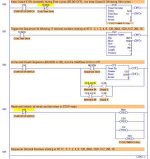Gobbling Ganster
Member
I am programming a sequencer to turn on turn the outputs on and off in the following manner. Only one output will be on at a time. 0→1→2→3→7→11→10→9→8→4 then repeat the sequence. I have this correct so far.
But I also want to turn on output 5 during the first cycle and all odd numbered passes and have 6 on during the second cycle and all even passes with it. This is the part I am having trouble with.
I tried adding in a counter to look at the odd and even counts but could not quit figure out how to do it, Some advice and tips would be great.
I can't seem to figure out how to attach what I have done so I will try explain it.
Rung000- NO Start I:1/0, NC t4:0/DN, TON Timer to turn on each output light every .5 seconds.
Rung 001- NO T4:0/DN, SQO with File: N7:0
Mask:FFFFh
Dest: 0:2
Control: R6:0
Length: 10
Postion:0
I hope you can visualize what I have. That part works but I cant seem to figure out how to tackle the part that I listed above.
But I also want to turn on output 5 during the first cycle and all odd numbered passes and have 6 on during the second cycle and all even passes with it. This is the part I am having trouble with.
I tried adding in a counter to look at the odd and even counts but could not quit figure out how to do it, Some advice and tips would be great.
I can't seem to figure out how to attach what I have done so I will try explain it.
Rung000- NO Start I:1/0, NC t4:0/DN, TON Timer to turn on each output light every .5 seconds.
Rung 001- NO T4:0/DN, SQO with File: N7:0
Mask:FFFFh
Dest: 0:2
Control: R6:0
Length: 10
Postion:0
I hope you can visualize what I have. That part works but I cant seem to figure out how to tackle the part that I listed above.





